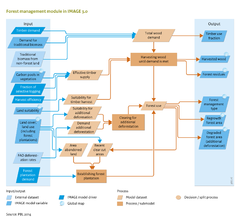Forest management/Data uncertainties limitations: Difference between revisions
Jump to navigation
Jump to search
Edelenbosco (talk | contribs) No edit summary |
Edelenbosco (talk | contribs) No edit summary |
||
| Line 14: | Line 14: | ||
Another uncertainty is the starting point, which is the state of forest use by age cohort in 1970. As forests take several decades to a century to regrow after felling, the effect of historic uncertainties in forest-use extends far into the future. | Another uncertainty is the starting point, which is the state of forest use by age cohort in 1970. As forests take several decades to a century to regrow after felling, the effect of historic uncertainties in forest-use extends far into the future. | ||
===Limitations=== | |||
<div class="version changev31"> | <div class="version changev31"> | ||
Timber demand in IMAGE 3.0 is the sum of the demand for sawlogs, pulpwood and fuelwood. This total demand is than used in harvesting forests across the world, without knowing anymore the underlying wood types. So, forest plantations, for example, can used to fulfill the demand for either sawlogs of fuelwood. For specific assessments (e.g. for timber use for modern biomass), it would have been useful to remain the three wood types in the allocation. | Timber demand in IMAGE 3.0 is the sum of the demand for sawlogs, pulpwood and fuelwood. This total demand is than used in harvesting forests across the world, without knowing anymore the underlying wood types. So, forest plantations, for example, can used to fulfill the demand for either sawlogs of fuelwood. For specific assessments (e.g. for timber use for modern biomass), it would have been useful to remain the three wood types in the allocation. | ||
Revision as of 12:16, 22 November 2016
Parts of Forest management/Data uncertainties limitations
| Component is implemented in: |
| Components: |
| Related IMAGE components |
| Projects/Applications |
| Key publications |
| References |
